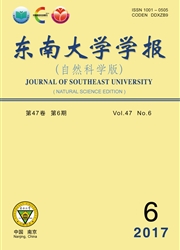

 中文摘要:
中文摘要:
为了提高盲源分离的准确率,提出了结合压缩感知(CS)与K均值奇异值分解(K-SVD)的稀疏分量分析方法进行盲源分离.首先,分析欠定盲源分离估计源信号与压缩感知问题的等价性,建立压缩感知框架;其次,在此框架下利用K-SVD方法训练稀疏字典;最后利用经典追踪算法计算得到稀疏分量,结合传统的两步法,进行盲源分离.大量实验表明,该算法与其他稀疏表示方法相比获得了较好的分离效果.与传统两步法不同的是,该算法在压缩感知框架下利用K-SVD方法自适应地训练稀疏字典,求出混合信号的稀疏表示,稀疏分量分析方法的改进对盲源分离的准确率起到直接的影响作用.
 英文摘要:
英文摘要:
To improve the precision of blind source separation,a method based on the compressed sensing(CS) and K-means singular value decomposition(K-SVD) is proposed.First,the equivalence between the problem of estimating the source in underdetermined blind source separation and the compressed sensing is analyzed and the framework of compressed sensing is built.Then K-SVD is used to train sparse dictionary self-adaptive under the framework.Finally the sparse component is computed using classic basis pursuit algorithm.Through lots of experiments the algorithm is proved to be a better algorithm,which inherits the advantages of sparse presentation ability and can significantly improve the precision of blind source separation.Different from traditional two steps methods,the algorithm proposed gets sparse presentation of signal taking a new way that combine CS and K-SVD,it shows that sparse presentation influences the result of blind resource separation directly.
 同期刊论文项目
同期刊论文项目
 同项目期刊论文
同项目期刊论文
 Chaos synchronization of fractional order time-delay Chen system and its application in secure commu
Chaos synchronization of fractional order time-delay Chen system and its application in secure commu Sound Source Localization of Digital Hearing Aids Using Wavelet Based Multivariate Statistical Metho
Sound Source Localization of Digital Hearing Aids Using Wavelet Based Multivariate Statistical Metho Acoustic feedback cancellation based on weighted adaptive projection subgradient method in hearing a
Acoustic feedback cancellation based on weighted adaptive projection subgradient method in hearing a Blind Multiple Access Interference Suppression Algorithm Based on Relaxed Subgradient Projection for
Blind Multiple Access Interference Suppression Algorithm Based on Relaxed Subgradient Projection for Two-dimensional canonical correlation analysis and its application in small sample size face recogni
Two-dimensional canonical correlation analysis and its application in small sample size face recogni 期刊信息
期刊信息
